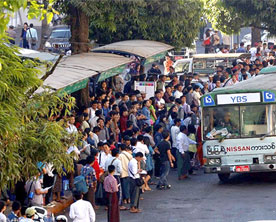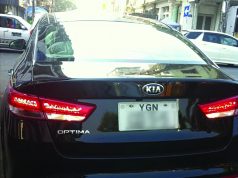F or residents of Yangon, the third week of January has been full of excitement, confusion, and frustration as the city embraced a new bus network starting from January 16. Reform of the city’s decades-old notorious public transit system is now a week in, but the shift has not been smooth.
The new Yangon Bus Service (YBS) replaced the infamous 300 bus lines registered under the Yangon Motor Vehicles Supervisory Committee known as Ma Hta Tha with 70 bus lines, which downsized the bus lines to eliminate overlap in a move to avoid “races” between buses—a practice in which vehicles compete for passengers and make unscheduled stops. Only 60 percent of the 3700 or so official YBS buses were available on the first day because of delays in applying numbered stickers to each bus displaying its route, according to bus owners and Yangon Region Transport Authority (YRTA) officials. Many good-natured drivers of private vehicles could be seen picking up weary commuters as they waited for buses to arrive. It was a good day for taxis, however, with reports of drivers charging above usual fares for frustrated commuters who gave up waiting for buses. The shortage of buses and the ensuing delays prompted private buses from express bus lines and from tourism companies to voluntarily offer transportation to commuters who were left stranded at bus stops. However, volunteerism lasted only for the first very five days and overcrowding at the bus-stops could be seen again in some routes. To solve this issue, the Yangon Region Transport Authority said the government would add additional buses in coming days and import more than 1,000 buses in total. “For now, about 500 buses are required immediately to fill the shortage and we are working to fill this very soon,” the secretary of YRTA said, adding that 100 imported buses would be in service the following week.
Yangon Chief Minister Phyo Min Thein, shortly before boarding the number 56 bus for a short jaunt downtown, said that another issue was in how fares are being collected. The Yangon Region government has made it clear that drivers and conductors can no longer work on commission or take a share of the daily profits, which government officials said prompted them to prioritise cash over quality of service and passenger safety.
“Some buses practised a system where commuters place the fare in a box,” he said. Some commuters were unfamiliar with this approach, overcrowding also made using the farebox difficult, and so less money was collected, he added. Other buses relied on the same conductors as they had previously employed, although conductors and drivers now work for set salaries. But Maung Aung said he had heard reports of some buses collecting extra fares.
“If commuters are faced with this they can complain immediately to the YRTA,” he said. Phyo Min Thein said that within three months there would be a new system where commuters can pay by electronic swipe cards.
That [kind of] system is not new, it’s international and we are late in using it,” the Chief Minister said. The government is in discussion with banks to design a card that can be used at mini-marts, restaurants and shopping malls as well as on buses, trains and a planned water taxi system, he added. The Chief Minister also addressed concerns that the Public-Private Partnership (PPP) firms operating YBS bus routes would not be profitable. “We do not believe this business will lose profits because there are over 2 million passengers,” he said. But he added that all bus companies would have to earn the public’s trust by providing good service. For conductor-driver teams used to years of competing with rival buses on the same route, this may require something of a shift in perspective, he said. “The bus owners and workers should think that it is not only their bus but also the company’s bus,” Phyo Min Thein said. “We want a sharing system and bus owners must get an equal share of profits, regardless of whether they operate in crowded or quieter routes.” Some commuters expecting to enjoy new flat fares of K200 for most routes inside the city – and a respite from arbitrary overcharging – found that the new system required using more than one route to get to work. But Phyo Min Thein said that the 70 YBS routes were not set in stone and that they could be changed or more added at commuters’ requests. The government is taking a particular look at people that have to take three separate routes to reach their destination, resulting in higher costs than under the old system. “According to passengers we need to add more buses, and I want people to know that we will not be too strict with routes,” he said. “If necessary, we will change them immediately.”
Although it was good seeing how the government following through and trying hard, to no one’s surprise, setting up a brand new public transport system was not easy. As there are mixed reviews coming from the public; rather than only the bad reviews, there is still hope in development of the new bus routes. Nevertheless, this whole changing the bus network is a great opportunity for the government to demonstrate their capabilities and for the people to judge how efficient the new government is in transforming the country.










